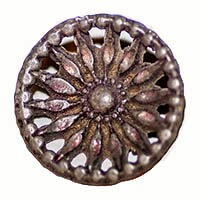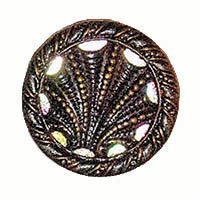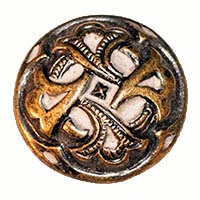I think antique metal buttons are some of the most beautiful
 buttons in the world. Many
different types of metals were used including silver, gold, steel, brass,
copper, aluminum and pewter or several metals were combined on one button. And
there are many different types of metal button; stamped. steel cups, twinkle,
cut steel, jewels and many others. Most military buttons were made out of metal
in the eighteen hundreds.
buttons in the world. Many
different types of metals were used including silver, gold, steel, brass,
copper, aluminum and pewter or several metals were combined on one button. And
there are many different types of metal button; stamped. steel cups, twinkle,
cut steel, jewels and many others. Most military buttons were made out of metal
in the eighteen hundreds. Stamped Metal Buttons
Metal buttons were often made with a cardboard center between the front of the button and the metal back containing the shank. Giant steam driven presses were used to stamp out thin sheets of metal into varied button designs. The buttons were assembled with a steel back and shank. Sometimes steel cups were used to form the base and other materials were used to fill this cup. A metal medallion in the shape of a flower or flower bouquet is often found.
 |
 |
 |
 |
 |
 |
Steel Cup Metal Buttons
The base of
these buttons are cup shaped, to varying degrees. The edge continues to the
front of the button to form a rim. The center of the button in the cup can be
made of steel, other metals, or something entirely different. The rims are often
beautifully formed, and the centers can
have exquisite detail.
 |
 |
Twinkle Metal Buttons
Twinkle buttons are popular with button collectors.
These buttons have several layers with a reflective layer of aluminum, silver,
or gold on the bottom. The top layer of the button consists of a pierced or
filigree metal that allows the 'twinkle' to shine through. Ladies and
gentlemen dining or dancing by candlelight enjoyed the sparkle of these buttons
on their elaborate evening attire.
 |
 |
 |
 |
Metal and other Material Buttons
Another type of metal button was the flat steel
button. These buttons were cast as flat disks and later etched and dyed
or cast with designs that were later enhanced with gold or paint. Metal
buttons could be adorned with almost any other material.
Jeweled Metal Buttons
 Jewel buttons have a 'stone' in the
center that is usually made out of glass. The glass could be flat, domed,
faceted, or cut into many pieces to form a mosaic design.
Jewel buttons have a 'stone' in the
center that is usually made out of glass. The glass could be flat, domed,
faceted, or cut into many pieces to form a mosaic design.
 Jewel buttons have a 'stone' in the
center that is usually made out of glass. The glass could be flat, domed,
faceted, or cut into many pieces to form a mosaic design.
Jewel buttons have a 'stone' in the
center that is usually made out of glass. The glass could be flat, domed,
faceted, or cut into many pieces to form a mosaic design.Cut Steel Metal Buttons

 Cut steel buttons were popular in the
nineteenth century. They consisted of small cut steel pieces with many
facets that were riveted together and used to trim buttons made out of a wide
variety of materials, shell, horn and bone. Originally, steel cut buttons
were made to simulate the expensive diamond or marcasite buttons worn by the
wealthy but they soon became popular in their own right. Men often wore
large steel cut buttons that flashed in the sunlight as a fashion statement.
Cut steel buttons were popular in the
nineteenth century. They consisted of small cut steel pieces with many
facets that were riveted together and used to trim buttons made out of a wide
variety of materials, shell, horn and bone. Originally, steel cut buttons
were made to simulate the expensive diamond or marcasite buttons worn by the
wealthy but they soon became popular in their own right. Men often wore
large steel cut buttons that flashed in the sunlight as a fashion statement.
Antique metal buttons can still be found today. Next time you discover some antique buttons,
take a moment to marvel at their workmanship, design, and beauty.
Read about Antique Glass Buttons
Read about Antique Glass Buttons





